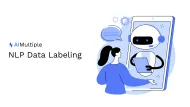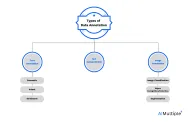Video Annotation: In-depth guide and Use Cases in 2024
As technologies such as facial recognition and autonomous driving become popular, the use of data annotation tools will also increase. The global data annotation market is projected to grow from $630 million in 2021 to over $3 billion by 2028, and video annotation accounts for a large portion of this market.
This article explores what video annotation is, why it is automated, and some use cases.
If you want annotated video datasets for AI training, check out our guide to the top video data collection services on the market.
What is video annotation?
Video annotation is similar to image annotation. It’s the process of teaching computers to recognize objects from videos. Image and video annotation are types of data annotation methods that fall under the field of computer vision (CV), which is the broader field of artificial intelligence (AI). The main is mainly used to enable a computer to imitate the perceptive characteristics of human eyes.
Human and automated video annotation tools add labels to objects in a video clip; then, by using AI and Machine learning (ML), computers process these labels and identify similar target objects in other videos without the labeled input.
In other words, video annotation mimics the identification process of objects in a video such as cars, motorcycles, and buses, as shown in the image below.
What is automatic video annotation?
Video annotation is a method of teaching AI and ML systems to mimic the human eye and an integral part of this process is labeling objects in videos. This requires a vast amount of data, managing that data is just not possible by human annotators. To ensure high accuracy and consistency of data labeling, organizations need to invest in sophisticated video annotation tools to automate data labeling.
Automatic video annotation refers to automatically labeling objects in the video clip through an annotation tool. The automation tool performs labeling without human input and with much higher precision and speed. This results in reduced data prep cycles and overall better performance of the AI model.
Most companies are now investing in data annotation tools to automate their video annotation process.
What are different methods for video annotation?
- Single frame annotation
This method of video annotation is done by dividing or separating the video into individual frames or images. This can be a time-consuming and costly method and is only suitable for videos where objects are moving less dynamically.
- Multi-frame / streaming annotation
In this method, the annotator uses data annotations tools to label objects as the video streams. This is a much faster and more effective way of video annotation, especially when the data volume is large. The object labeling is done with more precision and consistency. The multi-frame method has become more common as data annotation tools become popular.
Specialized video annotation tools can enable you with the different functionalities you need for your annotation project. Check out our sortable and filterable video annotation tools and data annotation services lists to choose the option that best fits your business needs.
What are some video annotation use cases and examples?
Some of the many uses of video annotation are:
Retail
- Video annotation can be used to improve retail AI systems to monitor how customers are reacting to the products
- It can also help track shopper movement in the store to help store managers in making product placement decisions.
- It can also help against shoplifting and theft through product recognition and alert security if products are not scanned at self-checkout counters.
Watch how this store uses video annotation to identify shelf products and customers:
Autonomous vehicles
Video annotation is widely used in autonomous vehicles to identify objects on the street and other vehicles around the car. Video annotation is also used in collision braking systems in vehicles. Companies also use video annotation to monitor unsafe driving behavior or monitor the driver’s condition.
Tesla’s autopilot system is also based on video annotation and computer vision.
Volvo uses an automatic emergency braking system in its semitrailer trucks to avoid collision
Traffic surveillance
Video annotation can also be used to monitor ongoing traffic to improve regulation. Traffic surveillance systems can monitor accidents and quickly alert authorities. Traffic congestion can also be analyzed through video annotation systems.
Watch how a city in Germany uses a smart traffic management system based on video annotation to improve its traffic conditions.
Surgery
Computer vision, enabled by video annotation and AI, is also being used in surgery. This technology is executed through augmented reality (AR) and enables remote surgery capabilities and the ability to share the surgery with clarity.
Proximie, a British company, is leveraging similar technology to connect surgeons from all over the world to patients through remote AR procedures.
Another system, based on similar technology, leverages machine vision to guide surgeons during surgery.
Sign language translation
Video annotation and computer vision technologies are also used for translating sign language into text and speech.
You can also check our sortable and filterable lists of video and data annotation tools and services to compare the options and choose the one that best suits your annotation needs:
Further reading:
- A Guide to Video Annotation Tools and Types
- Data Annotation: What it is & why does it matter?
- Image Annotation: What is it & why is it important?
If you have further questions please do not hesitate to contact us:



Comments
Your email address will not be published. All fields are required.